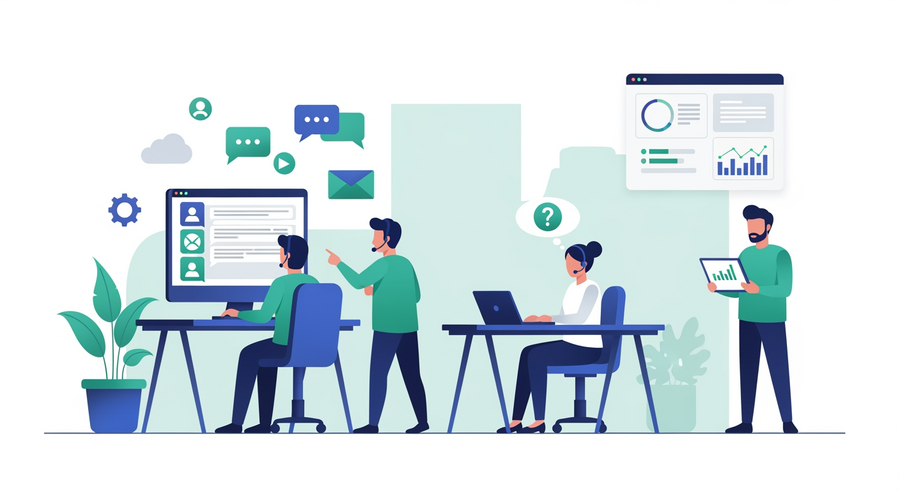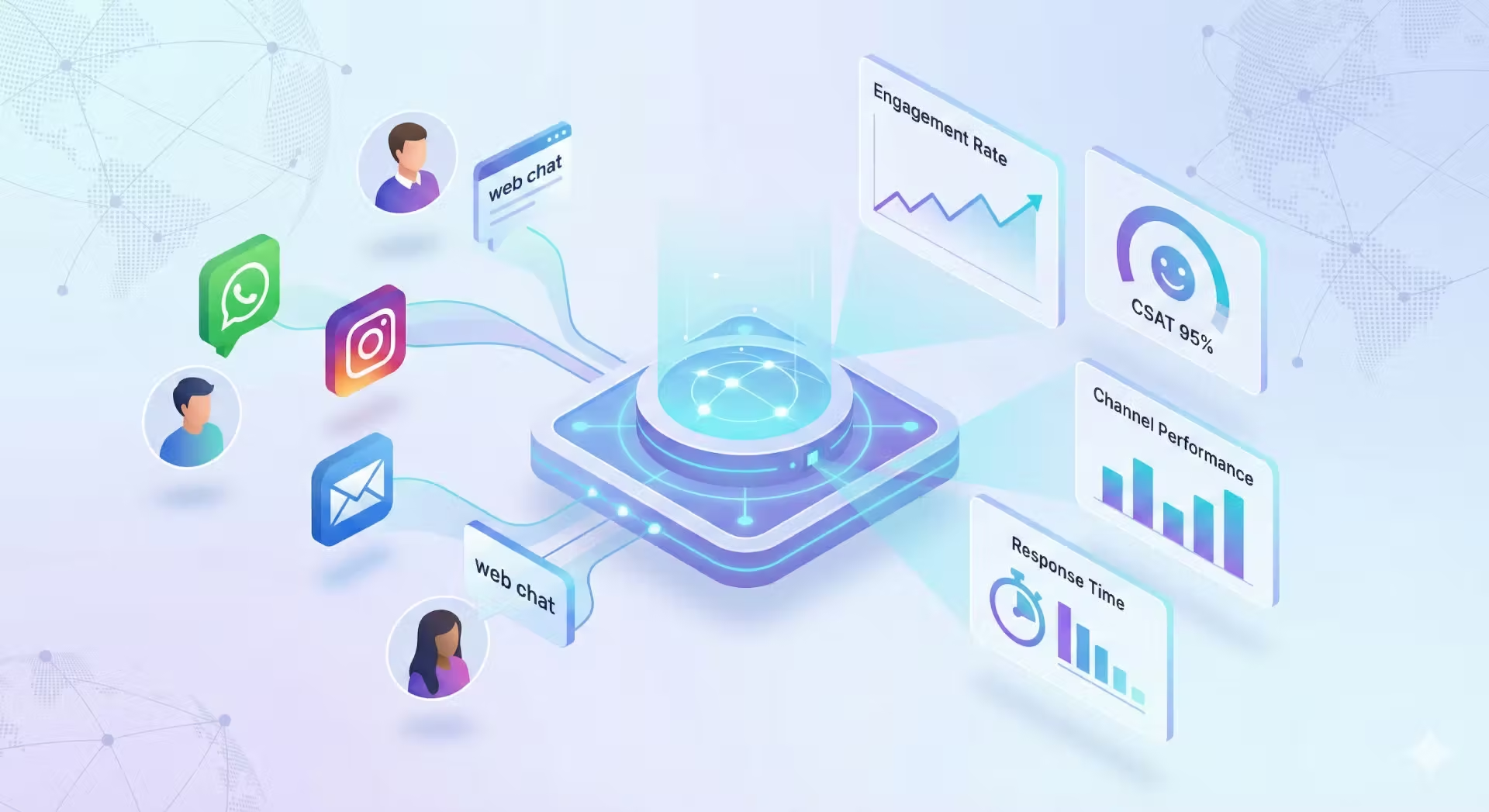We are entering the era of AI-powered chatbots – intelligent virtual assistants poised to redefine consumer services.
Immediate responses, round-the-clock customer support, and tailored messages are not just a luxury but have become standard offerings. Because AI chatbots created a new reality, where instant responses to queries, personalised recommendations, and seamless problem resolution are all on the table.
From booking appointments and handling transactions to troubleshooting issues and providing recommendations, AI chatbots are simplifying how consumers engage with businesses. They offer unparalleled convenience, efficiency, and accessibility, ensuring customer delight is within each team’s reach.
Let’s explain the transformative potential AI chatbots can have on customer experience and look at how they can drive business growth.
Chatbots then and now
AI chatbots are not exactly new. The groundwork for them dates back to the 1960s already. When simple rule-based programs like ELIZA were invented. These early efforts laid the groundwork for future innovations like complex systems capable of simulating realistic human conversations.
By integrating machine learning (ML) and AI in the 21st century, chatbots underwent rapid changes. Getting to modern AI chatbots that now offer personalised interactions by learning from each conversation. This has revolutionised how many businesses deliver their customer service.
What is an AI Chatbot?
An AI chatbot is software that uses artificial intelligence to simulate a conversation with users, or customers. Unlike traditional chatbots that follow predefined paths, AI chatbots understand and process customer inputs more naturally.
AI chatbots are powered by AI – obviously. They typically include technologies like Natural Language Processing (NLP) and ML which allow them to:
- Understand human inputs/customer requests
- Learn from their previous interactions
- Respond to human queries in a conversational manner
Unlike traditional rule-based chatbots that follow pre-defined scripts, AI chatbots can generate responses in real time, offering a personalised user experience.
💡These chatbots are not just programmed algorithms; they're evolving entities, continuously learning from interactions to deliver increasingly human-like responses. With natural language processing (NLP) capabilities, they understand context, tone, and intent, enabling fluid conversations that mimic human interaction.
The future of AI chatbots, and your customer experience
AI chatbots can now comprehend context, figure out user intent, and provide relevant, accurate responses. These capabilities have been crucial in AI chatbots’ success. McKinsey estimates that 75% of customers use multiple channels in their ongoing experience which highlights the need for seamless, omnichannel support that AI chatbots can provide.
In addition, by 2027, Gartner predicts chatbots will become the primary customer service channel for about 25% of businesses. This shift highlights the growing recognition of AI chatbots' ability to enhance customer service efficiency, personalise interactions, and meet consumers where they are, 24/7.
What is the difference between traditional rule-based chatbots and conversational AI?
Understanding the distinction between traditional rule-based chatbots and conversational AI can help you understand how chatbot technology has advanced and where it is likely to go in future.
Rule-based chatbots:
- Operate on predefined pathways
- Can only respond to specific commands or questions they are programmed for
- Lack the ability to understand context or intent
In short, these chatbots are very suitable for straightforward tasks or FAQs.
Conversational AI (AI chatbots):
- Use NLP and ML to understand and interpret human language
- Can engage in dynamic conversations, understand context, intent, and even emotions of the customer
- Capable of learning and improving from interactions over time
AI chatbots can be ideal for complex customer service, personalised interactions, and handling a wide range of queries.
When do you use AI chatbots, regular chatbots, or virtual agents?
Regular chatbots
Regular chatbots form the base technology that AI chatbots build upon, incorporating AI to enhance capabilities.
Use them for customer support FAQs
When your company's website receives a high volume of inquiries related to product features, shipping information, and return policies. Implement a regular chatbot to handle frequently asked questions (FAQs) and efficiently address common customer queries without the need for your team to get involved.
Benefit: Users can interact with the chatbot to quickly get answers, while you reduce wait times and improving overall customer satisfaction.
AI chatbot
AI chatbots are the next-level regular chatbots, offering more advanced, flexible, and personalised interactions.
Use them for personalised assistance
When you want to increase engagement enhance your online experience for customers by providing tailored recommendations and style advice. Deploy an AI chatbot to offer personalised shopping assistance. While customers are on a specific page, thinking about, a product or service the chatbot can pop up and suggest a recommendation, or perhaps show them to the frequently asked questions page.
Benefit: you’ll take away any doubts that customers can have, and lead them through customisation towards a purchase.
Virtual agents
Often used interchangeably with AI chatbots, virtual agents usually refer to AI-powered chatbots designed for specific, often more complex tasks. They represent the cutting edge of chatbot technology, embodying the full potential of AI in understanding and assisting customers efficiently.
Use them for consultations and appointment scheduling
Want to streamline patient, visitor or customer interactions and improve access to your services? Introduce a virtual assistant that’ll help people to schedule appointments, and access resources conveniently. The virtual agent utilises advanced AI algorithms to understand customer needs and recommend appropriate actions, such as scheduling appointments.
Benefit: a virtual assistant can deliver a personal touch. Enhancing engagement, while reducing administrative tasks for your team, and ensuring timely flows for everyday tasks.
What benefits do AI chatbots bring to customer service?
AI chatbots can deliver massive advantages to customer service when well implemented. Some key benefits include:
- Branded first touchpoint: AI chatbots offer a consistent brand experience from the first interaction. This helps create a positive first impression with your customers and maintains a consistent level of service.
- Personalisation in customer interactions: AI chatbots can analyse user data to deliver personalised responses. This can include giving your customers recommendations, helping them find the information they need faster and continuing support from previous interactions.
- Automated support: Capable of handling FAQs and routine inquiries, AI chatbots save your customer service teams a lot of time. An IBM study shows that AI-infused virtual agents can reduce labour costs by up to 30%, delivering a massive decline in customer support service fees.
- 24/7 availability and immediate responses: AI chatbots ensure your business is always available, providing instant responses to customer queries around the clock.
- Lead generation: By engaging prospects in meaningful conversations, AI chatbots effectively capture and qualify leads.
- Scalability and cost-effectiveness: AI chatbots handle interactions at scale, offering a cost-effective solution for your business to optimise its customer service operations. In addition, scalability benefits businesses that have higher volumes of inquiries during certain seasons as they can scale up and down as needed without the timely and costly process of hiring new customer support team members.
- Ultimate team player: Acting as an extension of your customer service team, AI chatbots free up your customer service team to focus on more complex and sensitive issues.
In 2022, chatbot interactions achieved a whopping 90% success rate, showing just how effective they really are in resolving customer queries efficiently. A major concern that businesses have is those chatbots will not be able to properly deal with customer inquiries the same way as humans. And yes, a chatbot is not the same as talking to a person. I would always suggest a healthy balance between AI, automation and your team. One where chatbots can relieve your team’s heavy workload.
How does an AI chatbot work?
AI chatbots have the power to transform the way your businesses interact with their customers, providing support and enhancing engagement across multiple sectors.
Here’s how they work for customer service interactions:
- Understand and learn: Through NLP and ML AI chatbots interpret user queries, learn from interactions, and deliver relevant responses. That information is absorbed by the AI chatbot and can be used in future responses meaning the quality of service grows with each interaction.
- Adaptation: They adapt to user behaviours and preferences, refining their responses over time for better personalization.
Where should I use an AI chatbot?
AI chatbots can be very helpful. Here are some obvious places to start when integrating AI into your customer engagement strategy.
Customer support and service
AI chatbots offer instant, round-the-clock assistance, efficiently handling inquiries and resolving common or simple problems, reducing wait times for your customers.
Sales and marketing automation
They engage potential customers, provide product information, and guide users through the purchasing process, enhancing lead generation and conversion rates.
Industry-specific applications
In sectors like automotive, travel & leisure, and hospitality, AI chatbots enhance customer experience by offering tailored recommendations, booking assistance, and immediate support. For example, Deltic Group3, the UK’s biggest administrator of bars and clubs set up an AI chatbot with great success. It used website visitors’ location to:
- Recommend nearby venues
- Give relevant venue information
- Direct the user to a customer service agent, if they show interest
How do I set up an AI chatbot?
Setting up an AI chatbot involves several key steps to ensure it aligns with your business needs and provides optimal customer service.
Here's a straightforward guide to follow:
1. Identify your goals
The ultimate goal is always to deliver customer delight. But break that down into smaller goals first. And determine what you want to achieve with your AI chatbot, such as:
- Reducing response times
- Handling FAQs
- Generating leads
- Collecting customer reviews
- Providing product information
2. Choose the right platform
Select a chatbot platform that suits your technical requirements and business objectives. Consider factors such as:
- Ease of integration
- Customisation options
- AI capabilities
- Data privacy and security
- Reporting
3. Design the conversation flow
Map out potential user interactions and responses.
For complex queries, decide how the chatbot should escalate the issue to a human.
4. Incorporate your brand’s voice
Ensure the chatbot’s responses reflect your brand’s tone and voice. This will provide a more consistent experience for your customers who likely interact with your brand across multiple channels.
5. Train your chatbot
Use your existing data and historic customer inquiries to train your chatbot. The more data it processes, the better it becomes at understanding and responding to user queries.
6. Integrate it with your tech stack
Ensure your AI chatbot can seamlessly integrate with your CRM and other key business systems. This will create a more unified customer service experience and make life easier for your customer service teams.
7. Test and refine
Before going live with your new AI chatbot, test it with a variety of scenarios or inquiries to ensure accurate and helpful responses. Collect all your feedback and use it to continuously refine your chatbot's performance.
8. Launch and monitor
Put your chatbot live and monitor its interactions. This is not a set-it-and-forget-about-it type of technology. You want to make sure that it is performing how you want it to and that you are making the most of the platform available to you. Use analytics to identify areas for improvement and to optimise its responses over time.
Challenges and considerations of implementing a customer service AI chatbot
Implementing AI chatbots can deliver huge benefits but it does also come with some challenges.
Here are a few that you should consider and plan for:
Ethical and Privacy Concerns
The ethical use and security of data collected through chatbot interactions are essential considerations for most businesses. You have to navigate data protection laws such as GDPR in Europe with transparency and handle data with care to maintain user trust.
Moreover, the imperative to minimise AI bias through diverse training datasets cannot be overstated, as it ensures fair and unbiased responses. We’ve all heard the stories of chatbots such as the one Microsoft created back in 2016 being taught to be racist, sexist and so on. You don't want this outcome for your chatbot so make sure to train it well.
Technical limitations
Despite rapid advancements, AI chatbots sometimes struggle with complex queries and maintaining conversation context. It's important to set realistic expectations for your AI chatbot and understand where and when things may get too complex for it.
💡I don’t believe your AI chatbot is a replacement for service team members. It’s team work, when questions are too complex for your chatbot, pass them on to your team. And vice versa, when questions are repetitive and too simple for your team to spend time on pass them to your chatbot.
Integration with your existing systems
For AI chatbots to perform at their best, they must integrate seamlessly with your existing digital infrastructure. This means you need to run a compatibility assessment and set out a clear strategy before you set up a new AI chatbot to ensure everything runs smoothly.
Continuous learning and improvement
The evolution of AI chatbots is driven by feedback and updated data. You will need to establish clear methods for continuous learning and adapting the chatbot based on customer interactions to make sure that it achieves optimum performance.
User acceptance
A common hurdle many businesses encounter is user acceptance. The success of AI chatbots also hinges on people actually using it. For that to happen you need to set realistic expectations with your customers and deliver an intuitive, user-friendly interface. Clear communication about the chatbot's capabilities and limitations plays an important role in user satisfaction and adoption.
What else is in store for AI chatbots?
AI chatbots continue to evolve and here are three key trends shaping the future of AI chatbots:
Reduction in search engine volume
Gartner predicts there will be a significant shift in how people access the information they need, forecasting a massive 25% drop in search engine volume by 2026. Normally, if you have a problem or are searching for a product, you turn to Google to help you find what you are looking for. But with AI chatbots and virtual agents getting better at providing this information in a fast and conversational way, the need for search engines will decline.
A generational shift in chatbot usage
The adoption and success of chatbots is being driven by the younger generations, most notably Millennials and Gen Z. These demographics have grown up with technology and are comfortable using chatbots.
For instance, around 20% of Generation Z shoppers prefer initiating customer service interactions through chatbots, a stark contrast to just 4% among baby boomers. This trend highlights the need for chatbots to cater to diverse communication preferences and maybe start tailoring responses based on a user's demographic data.
Chatbots in education
The education sector is embracing AI chatbots to streamline administrative tasks and enhance the student experience. From managing course registrations to answering FAQs, chatbots are providing quick information and support, improving efficiency and student engagement. This adoption signifies a broader trend of chatbots extending beyond customer service, into roles that support education and learning processes.
AI bots: A new era of digital communication and customer service
AI bots have long passed the ‘fad phase’. Now they represent a significant shift in how businesses and customers interact.
By embracing AI chatbot technology, your business can offer more personalised, efficient, and accessible services, meeting the evolving expectations of your customer base. If you want to simplify delivering customer delight — start looking into chatbots.
With the right tools and strategies, you can turn every interaction into an opportunity to build customer loyalty and fuel your business growth.




.png)











